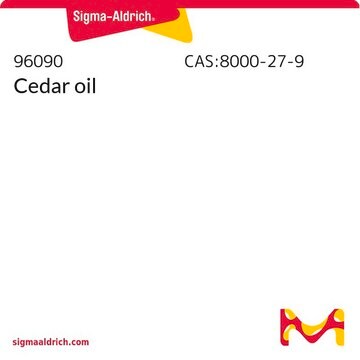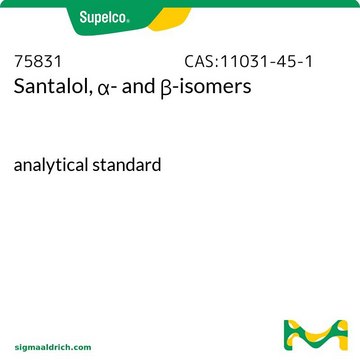All Photos(1)
About This Item
grade:
Halal
Kosher
natural
Kosher
natural
biological source:
Santalum album l.
food allergen:
no known allergens
Recommended Products
biological source
Santalum album l.
grade
Halal
Kosher
natural
optical activity
[α]20/D −15°, neat
refractive index
n20/D 1.507 (lit.)
bp
276 °C (lit.)
density
0.974 g/mL at 25 °C (lit.)
application(s)
flavors and fragrances
Documentation
see Safety & Documentation for available documents
food allergen
no known allergens
Organoleptic
woody; spicy; herbaceous; balsamic
Looking for similar products? Visit Product Comparison Guide
Related Categories
Preparation Note
Extraction method: steam distillation
Disclaimer
For R&D or non-EU Food use. Not for retail sale.
Signal Word
Warning
Hazard Statements
Precautionary Statements
Hazard Classifications
Eye Irrit. 2 - Skin Irrit. 2 - Skin Sens. 1 - STOT SE 3
Target Organs
Respiratory system
Storage Class Code
10 - Combustible liquids
WGK
WGK 2
Flash Point(F)
Not applicable
Flash Point(C)
Not applicable
Personal Protective Equipment
dust mask type N95 (US), Eyeshields, Gloves
Choose from one of the most recent versions:
Already Own This Product?
Find documentation for the products that you have recently purchased in the Document Library.
C Dwivedi et al.
European journal of cancer prevention : the official journal of the European Cancer Prevention Organisation (ECP), 6(4), 399-401 (1997-08-01)
The essential oil, emulsion or paste of sandalwood (Santalum album L) has been used in India as an ayurvedic medicinal agent for the treatment of inflammatory and eruptive skin diseases. In this investigation, the chemopreventive effects of sandalwood oil (5%
Pankaj P Daramwar et al.
The Analyst, 137(19), 4564-4570 (2012-08-18)
The major sesquiterpene constituents of East-Indian sandalwood oil (Z)-α- and (Z)-β-santalols have shown to be responsible for most of the biological activities and organoleptic properties of sandalwood oil. The work reported here describes the strategic use of medium pressure liquid
Biswapriya B Misra et al.
Phytomedicine : international journal of phytotherapy and phytopharmacology, 20(5), 409-416 (2013-02-02)
Sandalwood finds numerous mentions across diverse traditional medicinal systems in use worldwide. The objective of this study was to evaluate the in vivo anti-hyperglycemic and antioxidant potential of sandalwood oil and its major constituent α-santalol. The in vivo anti-hyperglycemic experiment
W Larsen et al.
American journal of contact dermatitis : official journal of the American Contact Dermatitis Society, 9(4), 202-206 (1998-11-11)
To determine the frequency of responses to four mixtures of fragrance materials in routine clinic patients undergoing patch testing for suspect allergic contact dermatitis. The validity of using fragrance mixtures alone, or in combination, was evaluated in terms of predicting
Ajay Bommareddy et al.
Phytomedicine : international journal of phytotherapy and phytopharmacology, 19(8-9), 804-811 (2012-05-11)
The anticancer effects of α-santalol, a major component of sandalwood oil, have been reported against the development of certain cancers such as skin cancer both in vitro and in vivo. The primary objectives of the current study were to investigate
Global Trade Item Number
| SKU | GTIN |
|---|---|
| W300500-100G-K | 4061838093585 |
| W300500-1KG-K | |
| W300500-25G | |
| W300500-SAMPLE | |
| W300500-100G | |
| W300500-1KG | |
| W300500-25G-K | 4061838079985 |
| W300500-SAMPLE-K | 4061837518379 |
Our team of scientists has experience in all areas of research including Life Science, Material Science, Chemical Synthesis, Chromatography, Analytical and many others.
Contact Technical Service






